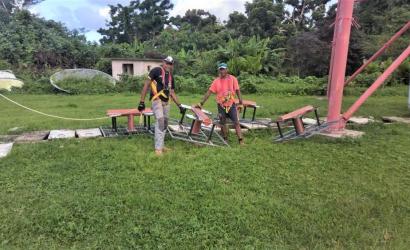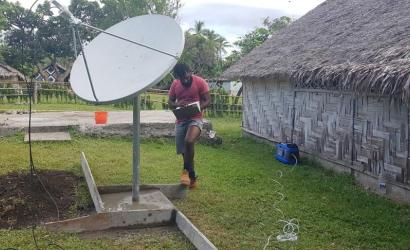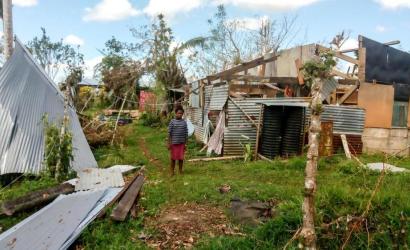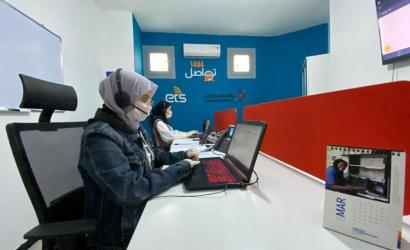Vanuatu
Located within the Pacific Ring of Fire, the Republic of Vanuatu remains one of the world’s most disaster-prone nations. Its exposure to frequent tropical cyclones, earthquakes, tsunamis, volcanic eruptions, and coastal flooding continues to threaten lives and livelihoods. The December 2024 Port Vila earthquake, one of the most devastating in recent history, claimed 14 lives, displaced over 1,000 people, and caused an estimated US$197 million in direct damages — nearly 17 percent of the country’s GDP. This came on the heels of three major cyclones in 2023, leaving the nation in a near-constant state of recovery.
Vanuatu’s Climate Change and Disaster Risk Reduction Policy (2022–2030) outlines its resilience strategy, but the socioeconomic toll remains high. With a GDP per capita growth forecast of just 2 percent in 2025 and a poverty rate estimated at 35 percent, rural communities that are dependent on agriculture, tourism, and fisheries are especially vulnerable.
Vanuatu's telecommunications infrastructure relies on a major submarine fiber-optic cable, supplemented by a network of mobile towers for 4G services, and satellite communication for internet where fibre is unavailable. The landscape presents challenges, particularly in reaching remote areas, but ongoing ICT policies and investments by companies like Digicel and Telecom Vanuatu, alongside efforts like the Universal Access Policy, are improving connectivity across the island nation.
Following the 2024 earthquake that severed Vanuatu's only undersea cable for 10 days, the Government, with support from the provate sector, is advancing the TAMTAM SMART cable project, which aims to is being advanced to enhance connectivity and disaster monitoring by linking Vanuatu and New Caledonia with a cable incorporating seismic and environmental sensors. This initiative, a joint effort between Vanuatu's government and the private sector, aims to provide a backup communication link and a real-time ocean floor monitoring system for earthquakes, tsunamis, and climate change.
ICT Profile
National Disaster Management Office (NDMO)
- Website | Facebook
- Telephone: +678-22699 / +678-33366
- Email: ndmo@vanuatu.gov.vu
The National Emergency Telecommunications Cluster (NETC) was established in 2016 as a national coordination mechanism for emergency telecommunications, with the Office of the Government CIO as lead.
Office of the Government Chief Information Officer (OGCIO)
Telecommunications Radiocommunications and Broadcasting Regulator (TRBR)
299,882
Source: World Bank 2019
Vanuatu has a population of less than 300,000 people and well over 50% of its mobile connections still access 2G services. In addition, it is one of the most vulnerable places on earth in terms of natural disasters and a substantial number of its population do not have access to electricity.
Despite this, telecoms services have progressed significantly in recent years with a liberalised market; the existence of two prominent mobile operators including Amalgamated Telecom Holdings (operating as TVL) and Digicel Vanuatu; the launch of LTE services and introduction of a rural satellite broadband service by Kacific. Over the next few years we will see an increase in both 4G LTE and 3G as 2G declines.
While fixed broadband penetration remains low in Vanuatu, the incumbent operator is slowly exchanging fixed-lines for fibre-optics and there are a number of ongoing submarine cable developments which will assist to increase speeds and lower Internet pricing.
Source: Business Wire
Vatu (VT)
4.4 (medium)
Source: INFORM Risk Index 2021
678
.vu
Voltage: 230V 50HzHz; Plug: Three Pin (Flat)
National Emergency Telecommunications Cluster (NETC)
No
There are three international airports in Vanuatu, situated in Port Vila, Efate; Luganville, Espirito Santo; and Whitesands, Tanna. It is important to note that there is no fuel depot in Tanna, so aircrafts must have enough fuel for a return journey via a refuelling port if the first porting is Tanna. It is recommended for flights to go via Port Vila or Espirito Santo first where possible.
The two international wharfs in Port Vila and Espiritu Santo are being upgraded to meet increased demands in supplies and tourism. Both wharfs are scheduled for completion in 2017 and will include cargo warehouse facilities.
There is a shortage of warehouse space in Vanuatu. Two disaster warehouses are scheduled to be built by the end of 2017: one of approximately 100m2 in Port Vila, on the corner of wharf road; and a smaller one in Luganville, close to the Provincial Disaster and Climate Change Office.
1.6
Source: ITU ICTeye 2018
80
Source: ITU ICTeye 2018
1.6
Source: ITU ICTeye 2018
44
Source: ITU ICTeye 2018
50.6 (low-med)
Source: GSMA Intelligence 2019
90
Source: GSMA Intelligence 2019
This describes some of the regulations and rules related to emergency telecommunications in Vanuatu.
This act provides for the organization, functioning, powers and responsibilities of the National Disaster Committee and the National Disaster Management Office of Vanuatu, and for the elaboration of national and provincial disaster plans.
An Act which established a new regulatory framework for telecommunications, radiocommunications and for related purposes. It established the Telecommunications and Radiocommunications Regulator (“the Regulator”), its general powers and functions including other matters relating to the telecommunications sector of Vanuatu.
Drone use is allowed in Vanuatu, but there are several drone laws that need to be followed when flying in the country.
Operators must ensure that they follow the following drone laws when flying in Vanuatu,
- Do not fly your drone over people or large crowds
- Respect others privacy when flying your drone
- Do not fly your drone over airports or in areas were aircraft are operating
- You must fly during daylight hours and only fly in good weather conditions
- Do not fly your drone in sensitive areas including government or military facilities. Use of drones or camera drones in these areas are prohibited.
- Do not fly your drone higher than 400 feet
- Do not fly your drone farther than 4km
The Broadcasting and Television Act mandates the Vanuatu Broadcasting and Television Corporation (VBTC) to administer broadcast licensing.
Tampere Convention - Vanuatu not a signatory
The Tampere Convention on the Provision of Telecommunication Resources for Disaster Mitigation and Relief Operations came into force 8 January 2005, following the ratification by 30 countries.
The Tampere Convention calls on States to facilitate the provision of prompt telecommunication assistance to mitigate the impact of a disaster, and covers both the installation and operation of reliable, flexible telecommunication services. Regulatory barriers that impede the use of telecommunication resources for disasters are waived. These barriers include the licensing requirements to use allocated frequencies, restrictions on the import of telecommunication equipment, as well as limitations on the movement of humanitarian teams.





